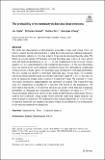The probability of intransitivity in dice and close elections
Author(s)
Hązła, Jan; Mossel, Elchanan; Ross, Nathan; Zheng, Guangqu
Download440_2020_Article_994.pdf (668.9Kb)
Publisher with Creative Commons License
Publisher with Creative Commons License
Creative Commons Attribution
Terms of use
Metadata
Show full item recordAbstract
Abstract
We study the phenomenon of intransitivity in models of dice and voting. First, we follow a recent thread of research for n-sided dice with pairwise ordering induced by the probability, relative to 1/2, that a throw from one die is higher than the other. We build on a recent result of Polymath showing that three dice with i.i.d. faces drawn from the uniform distribution on
$$\{1,\ldots ,n\}$$
{
1
,
…
,
n
}
and conditioned on the average of faces equal to
$$(n+1)/2$$
(
n
+
1
)
/
2
are intransitive with asymptotic probability 1/4. We show that if dice faces are drawn from a non-uniform continuous mean zero distribution conditioned on the average of faces equal to 0, then three dice are transitive with high probability. We also extend our results to stationary Gaussian dice, whose faces, for example, can be the fractional Brownian increments with Hurst index
$$H\in (0,1)$$
H
∈
(
0
,
1
)
. Second, we pose an analogous model in the context of Condorcet voting. We consider n voters who rank k alternatives independently and uniformly at random. The winner between each two alternatives is decided by a majority vote based on the preferences. We show that in this model, if all pairwise elections are close to tied, then the asymptotic probability of obtaining any tournament on the k alternatives is equal to
$$2^{-k(k-1)/2}$$
2
-
k
(
k
-
1
)
/
2
, which markedly differs from known results in the model without conditioning. We also explore the Condorcet voting model where methods other than simple majority are used for pairwise elections. We investigate some natural definitions of “close to tied” for general functions and exhibit an example where the distribution over tournaments is not uniform under those definitions.
Date issued
2020-08-19Department
Massachusetts Institute of Technology. Department of MathematicsPublisher
Springer Berlin Heidelberg